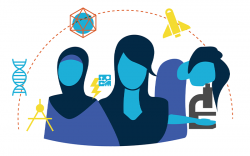Meet Dr. Katrina Mealey, Veterinary Pharmacologist and Notable Woman in STEM

Can you explain to us what you do?
Pharmacogenetics for dogs and cats! That means that I discover genetic changes in certain dog or cats breeds that make those particular animals more susceptible to deadly adverse drug reactions. We can then test dogs and cats for those genetic changes so we don’t use treatments that would cause potentially deadly adverse drug reactions.
What was your education and/or career path? How did you get where you are now?
I am a product of public schools (elementary through high school) and state schools. I got my Bachelors of Science in Pharmacy from the University of New Mexico, Doctor of Veterinary Medicine from Colorado State University, and PhD in Pharmacology from Texas A&M University. I was hired by Washington State University after finishing my PhD and have advanced to the rank of Regents Professor.
What/who were some of your most important influences that guided you to STEM?
My mother, Maria Gonzales Larson, who was one of only a few women, especially Hispanic women, to earn a degree in mathematics from New Mexico State University at that time.
Here at WA STEM we are starting to talk about “math identity.” A positive math identity – knowing you can do math and that you belong in mathematics – helps students succeed in STEM. What were some of your earlier experiences in math, and how do you think that impacted your career choice?
Having a mom that was a mathematician put some pressure on my brothers and me to be successful in math. However, I was not patient enough to be tutored by my mother, so I had to try to work with my teachers if I had questions or struggled with a particular concept. Math is absolutely essential to what we do every day in our work as veterinarians.
What is your favorite part of your job?
Knowing that we are saving the lives of dogs and cats and improving their quality of life. This also positively affects their owners and decreases the cost of veterinary care.
What do you consider your biggest achievement in STEM?
Discovering an important genetic mutation in dogs and cats that has had a positive impact on millions of dogs, cats, and their owners. This patented technology has generated more than $4 million in royalties for Washington State University.
Are there any stereotypes about women in STEM you’d like to personally dispel?
The stereotype that women can’t or don’t work well together is simply wrong. I would not be where I am today without the help of many women mentors and colleagues.

What unique qualities do you think you bring to STEM?
Perseverance. I think that someone of average intelligence and higher-than-average perseverance will ultimately be more successful than someone of higher-than-average intelligence and average perseverance.
How do you see science, technology, engineering, and/or math working together in your current job?
It is an everyday event. My job is a conglomeration of science, technology, engineering, math, and communications.
What would you like to say to young women thinking about beginning a career in STEM?
STEM degrees provide so many career options with opportunities for a good salary—I strongly recommend a career in STEM.
Can you share a fun fact about yourself?
I am a marathon runner which I think helps my creativity. Also, my first job was as a car hop at a Sonic Drive-In.